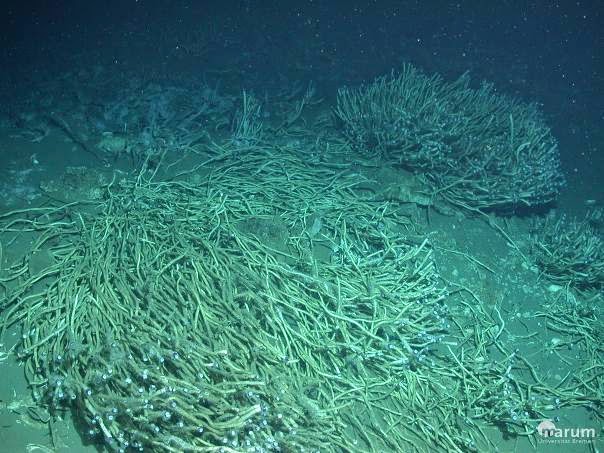20
o37.710'N 92
o48.406'W
We are currently under stand-by due to rough seas. METEOR is mapping the bathymetry with its swath mapping system, but it is too rough to use the ROV. For my blog today I am excerpting the ROV dive report from yesterday, when we completed a successful sampling of the bubble source that we have been exploring over the last few days. Reports like this are written for each dive. There is typically one scientist assigned to compile all the notes and prepare a summary for each dive for the log. Yesterday was my turn to be the responsible scientist and this is part of what I wrote.
Dive 352 (Station 74-1, GeoB: 19317-1)
Area:
UNAM Ridge
Water Depth: 1200 - 1250 m
Date: Thursday 05 March 2015
ROV in water: ca. 11:00
Bottom time: ca. 5 hours
Location ROV goes down: 19o55.856'N 94o20.550'W
Key Results:
The objective of this dive was to find and collect samples from the source of the A4 gas flare that had been identified in previous acoustic surveys. The original dive plan was to search with sonar ~10m above bottom, then to descend for sampling when the bubbles were found.
After the dive began, the sonar was not functioning, so the search proceeded visually at seafloor level. The ROV approached the A4 location from the NE and soon encountered white mats, then found a field of large asphalt boulders with extensive eipfauna (fig. 1). The seafloor was covered with mussel shells, but all appeared to be dead. After a brief exploration, we continued to a pockmark about 10m SW from the asphalt. The pockmark was steep-sided, ~1.25m in diameter and 0.5m deep, with large carbonates around and a small ridge on the upslope (southern) side of the feature. Sediments had white mats or precipitates. There were a few living mussels in the pockmark and some tube worms and several more mussels attached to the larger carbonates. A few bubbles were observed, but their source was not evident at this time. Although the ROV briefly touched the bottom, we did not land at this point. The mosaicking camera (Prosilica) was not functioning, so we could not collect down-looking images for mosaics.
 |
Figure 1. Asphalt with eipfauna encountered early in dive.
(Scorpio_dive352_2015_03_05 17-47-22.jpg) |
We continued to explore heading SW and after about 20m came to a large area with carbonate boulders and broken pavement. Tube worms were extensive here including upright clusters of living animals surrounding an interior area with dead, recumbent worms (fig. 2). Dead mussel shells were seen within the cracks and fissures, but there appeared to be no living mussels. We continued another 15m or so until the carbonate substratum was replaced by open sediments with sparse white mats. At this point, time was limited, so we decided to return to the pockmark for our sampling.
 |
Figure 2. Tube worms and carbonates encountered SW from pockmark
(Scorpio_dive352_2015_03_05 18-05-32.jpg) |
After reaching the pockmark, we maneuvered over the ridge-like feature (suspected to be hydrate) and collected a vertical profile of 7 water samples with the niskin rack at approximately 0.5, 1.5, 2.5, and 3.5 m above bottom. The ROV then backed down and landed so it was facing the pockmark heading about 060
o on the downslope side (fig. 3). Single bubbles were observed coming from a small vent mid-way up the crater wall (labeled -9 in fig. 3). The gas bubble sampler #1 was used to capture the bubbles - count 117 bubbles in total -- and then the valve was cycled open and closed to trap the gas in the pressure chamber. With time running out because of an approaching weather front, we collected carbonate rocks and a scoop net of rock and mud, then collected several mussels in two nets before terminating the dive. Copious gas and pieces of hydrate were released from the sediments as the scooping and maneuvering of the ROV disturbed the interface.
Technical discussion:
Problems encountered were non-functioning sonar and Prosilica camera. It is not clear that lack of sonar impacted the dive as the bubble source appears to have been found. A mosaic of the pockmark would have been useful. The niskin rack was successful for all 7 bottles, but a different camera placement would allow observation of all the bottles closing in case of difficulty. Avoiding contamination of the ROV by not contacting the bottom prior to water collection was highlighted by the large releases of gas during the collections. A preliminary analysis of the water samples shows near background CH
4 levels despite collection next to the bubble stream. Had water been collected after the sediments were disturbed, the CH
4 concentrations would unlikely have been so low. Shortening of the dive due to weather prevented collection of T-profile and push cores.
 |
Figure 3: Pockmark sampling site with sample collections and GeoB numbers marked
See table for samples list.
(M114_dive352_cam_zeus_toolskid_2015-03-05_19-16-20.jpg) |












